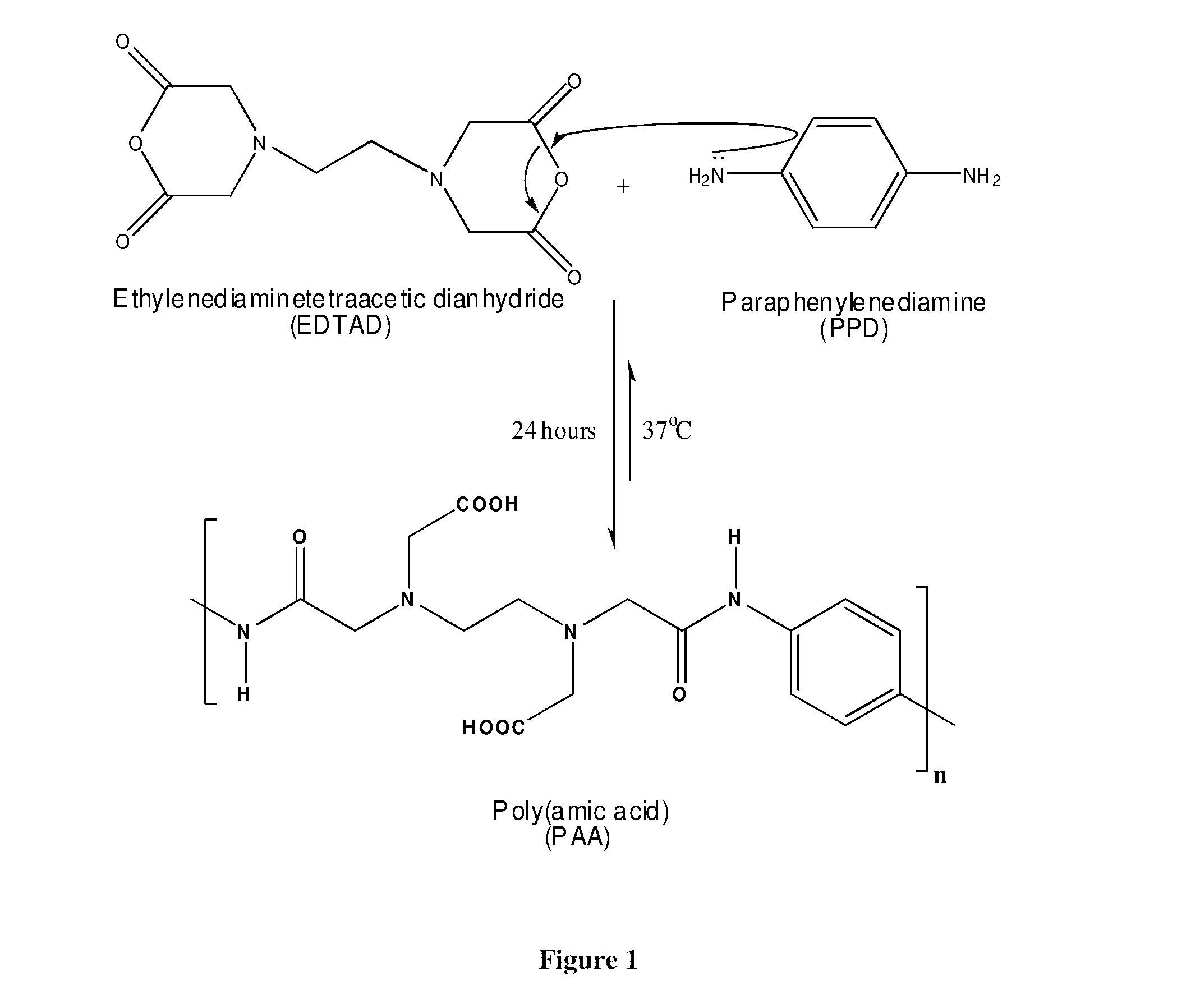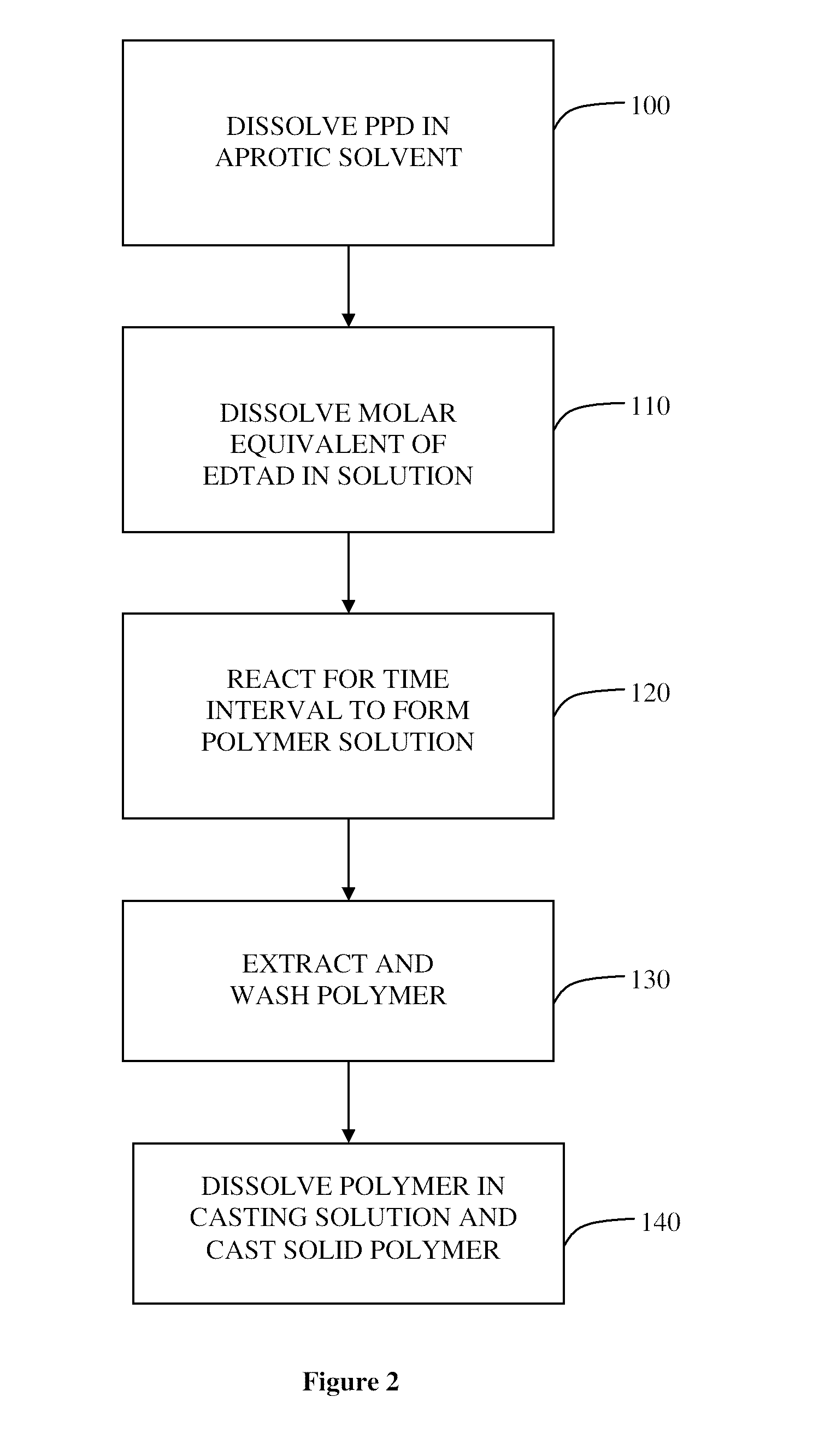Biocompatible poly (amic acid) and method of preparation thereof
a biocompatible polymer and acidic acid technology, applied in the field of polyamic acid acid and its preparation, can solve the problems of limited polyester applications, inability to meet the needs of patients, and inability to meet the needs of patients, and achieve the effect of confirming cell viability on paa
- Summary
- Abstract
- Description
- Claims
- Application Information
AI Technical Summary
Benefits of technology
Problems solved by technology
Method used
Image
Examples
example 1
Synthesis of PAA Films
[0048]Samples of the PAA polymer were prepared using the dianhydride monomer EDTAD (Sigma Aldrich, Oakville, Canada) and the diamine monomer PPD (Thermo Fisher Scientific Company, Acros, Belgium). The EDTAD was received sealed under nitrogen to avoid moisture, had a purity of 98% and was used immediately upon breaking the seal. The PPD was of high purity and was used as received. All organic solvents; N-methyl-2-pyrrolidone (NMP), N,N dimethylformamide (DMF), dimethyl sulfoxide (DMSO) and N,N-dimethylacetamide (DMAc) were also obtained from Sigma Aldrich in sealed vials and either used directly after opening or were dried over molecular sieves having a nominal pore diameter of 3 Å and filtered prior to use. The chemicals needed for preparing the Phosphate Buffered Solution (PBS) [sodium chloride (NaCl), potassium chloride (KCl), disodium hydrogen phosphate (Na2HPO4) and potassium dihydrogen phosphate (KH2PO4)] were also purchased from Fisher Scientific.
[0049]In...
example 2
Characterization of PAA Films
[0052]Attenuated Total Reflectance—Fourier Transform Infrared (ATR-FTIR; Pike Technologies Inc., Madison, Wis.) spectroscopy was used to analyze chemical structure and conformation of the PAA film. Infrared spectra were obtained with a horizontal ATR attachment using a diamond crystal on a Bruker Vector 22 FTIR spectrometer (Milton, ON). Spectra were recorded with 128 signal averaged scans at resolution of 4 cm−1 and displayed in absorption mode. All spectra were normalized and smoothed using OPUS-NT 3.1 software to enhance the signal to noise ratio.
[0053]FTIR spectroscopy analysis was used in the range of 1500-1700 cm−1 and 2800-3500 cm−1. FIG. 3 shows the representative ATR-FTIR spectra for the PAA film. As anticipated, common bands associated with PAA appeared at approximately 1675 cm−1 (amide I) and 1520 cm−1 (amide II), corresponding to the stretching vibration of C═O band and combination band of N—H bending and C—N stretching vibration respectively...
example 3
Assessment of PAA Biocompatibility
[0063]Primary cultures of porcine radial artery cells (RACs) and porcine descending aorta endothelial cells (ECs) were isolated as previously described [5, 6]. Radial artery cells were maintained in Medium 199 (M199) supplemented with 10% fetal bovine serum (FBS) and 1% Penicillin / Streptomycin (Invitrogen Canada, Burlington, ON). ECs were maintained in endothelial growth medium (EGM) with 5% FBS, 1% Penicillin / Streptomycin and a bullet kit containing rhEGF, rhFGF-B, VEGF, R3-IGF-1, gentamicin / amphotericin, hydrocortisone, and ascorbic acid (Lonza Canada Inc., Shawinigan, QC). All cells were maintained at 37° C. under humidified gas mixture of 95% air / 5% CO2. RACs (passages four to six) and ECs (passages three to five) were independently seeded onto PAA coated cover slips at an initial cell density of 7,000 cells / cm2. Uncoated cover slips were seeded at the same density to serve as time-matched controls. Cell growth and adhesion was examined at 4, 8,...
PUM
| Property | Measurement | Unit |
|---|---|---|
| temperature | aaaaa | aaaaa |
| temperature | aaaaa | aaaaa |
| time | aaaaa | aaaaa |
Abstract
Description
Claims
Application Information
 Login to View More
Login to View More - R&D
- Intellectual Property
- Life Sciences
- Materials
- Tech Scout
- Unparalleled Data Quality
- Higher Quality Content
- 60% Fewer Hallucinations
Browse by: Latest US Patents, China's latest patents, Technical Efficacy Thesaurus, Application Domain, Technology Topic, Popular Technical Reports.
© 2025 PatSnap. All rights reserved.Legal|Privacy policy|Modern Slavery Act Transparency Statement|Sitemap|About US| Contact US: help@patsnap.com



